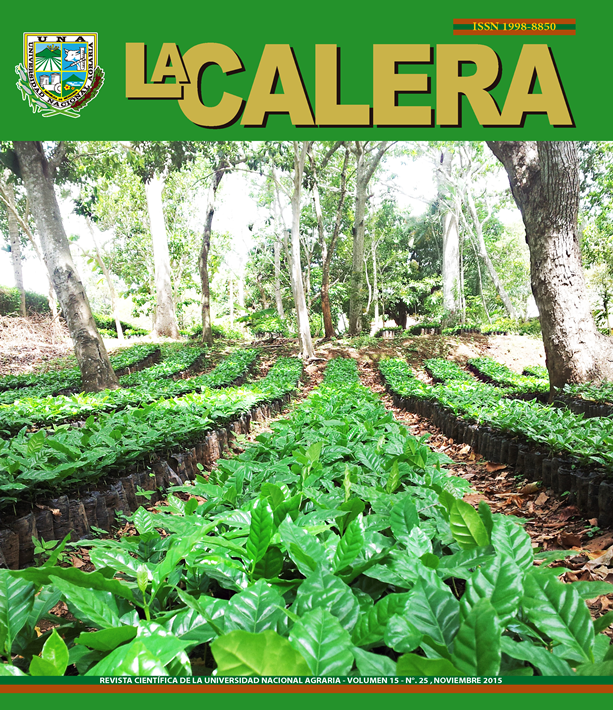Evaluation of botanical insecticides to control whitefly (Bemisia tabaci Gennadius) and tomato flee (Halticu ssp) in tomato (Solanum lycopersicum Mill.), in Nicaragua
Keywords:
Begomovirus, insect, pesticidesAbstract
The whitefly-virus complex (Bemisia tabaci)-Geminivirus and Halticus sp. are the main cause of economic losses in tomato (Solanum Lycopersicum Mill) in the municipality of Tisma, Masaya. Due to this situation, a study was conducted to evaluate the effectiveness of botanical insecticides such as: Chile + Garlic + Soap, Madero Negro, Chrysanthemum, alcoholic extract + Chili and alcoholic extract + Chili + Garlic in the period from December 2013 to February 2014. Of the treatments evaluated, the lowest number of whiteflies per plant and lower percentage of severity at one hundred days after transplanting was obtained with the treatment Alcoholic extract+Chili+Garlic. The treatment Madero Negro had the highest effectiveness in managing populations of Halticus sp. The economic analysis showed that the highest yield was obtained by the Alcoholic extract+Chili+Garlic with 34 685.18 kg/ha-1 followed by the treatment Chili+Garlic+Soap with 30 614.28 kg/ha-1. According to the marginal return analysis, this proved that the treatment Chili+Garlic+Soap is the one who obtained the best marginal rate of return with 1 476 %, which means that USD 14.76 is obtained for every dollar invested. According to samples of tomato tissue and whiteflies insect samples sent for analysis to at the University of Arizona in Tucson, this determined that the 66.66% of white flies samples from Tisma are indigenous whitefly, biotype “A”, and the 33.33% corresponds to the “B” biotype, the one that is more aggressive than “A”. The Begomoviruses analysis found that severe curl leaf tomato (ToSLCV) with at least 96% and golden mosaic virus of pepper (PepGMV) with 98% identity were identified in this study.
Downloads
Metrics
References
Alemán, F. 2004. Valoración económica en experimentación agrícola. In Manual de investigación agronómica: con énfasis en ciencias de las malezas. Managua, NI. 189 p.
Álvarez, D; Sánchez, K. 2014. Mosca blanca (Bemisia tabaci): Generalidades y biotipos (en línea). Consultado el 6 oct. 2014. Disponible en http://www.tec-digital.itcr.ac.cr/file/6323410/Bemisia_tabaci.pdf
AMUNIC (Asociación de Municipios de Nicaragua). 2005. Municipios: Caracterización de municipios de Masaya (en línea). Consultado el 9 de agos. 2010. Disponible en http//www.amunic.org/
CATIE (Centro Agronómico Tropical de Investigación y Enseñanza, CR). 1990. Guía para el manejo integrado de plagas para el tomate. Proyecto regional MIP. (Serie Técnica. Informe Técnico/ CATIE; n° 151). Turrialba, CR. 138 p.
CYMMYT (Centro Internacional para el Mejoramiento del Maíz y el Trigo, MX). 1998. La formulación de recomendaciones a partir de datos económicos. Un manual metodológico de evaluación económica. 79 p.
Gómez, D; Vásquez, M. 2011. Manejo de plagas (en línea). Tegucigalpa, HN. Consultado 19 oct. 2014. Disponible en http://www.sitrural.cl//wp-content/plugins/downloads-manager/upload/plagas.pdf.
Hilje, L. 1996. Metodología para el estudio y manejo de moscas blancas y geminivirus. CATIE, Turrialba, CR. 133 p.
INTA (Instituto Nicaragüense de Tecnología Agropecuaria). 2004. Introducción. In guía técnica sobre el manejo integrado de plagas en el cultivo del tomate. Managua, NI. p. 3
Jarquín Palacios, DA. 2004. Evaluación de cuatro líneas de tomate (Licopersicum sculentum), basado en el complejo mosca blanca (Bemisia tabaci)-geminivirus, en la comunidad de Aponpúa, Potosí, Rivas, Nicaragua. Tesis. MSc. Sistemas integrales de producción agropecuaria en el trópico, con énfasis e recursos naturales. Managua, NI. Universidad Autónoma de Barcelona-
UNA. 73 p.
Jiménez-Martínez, E. 2007. Guía de manejo integrado de mosca blanca y virus en Nicaragua. Universidad Nacional Agraria. Managua, NI. 30 p.
Jiménez-Martínez, E; Gutierrez, W; Gonzalez, C. 2010. Evaluación de cuatro variedades de tomate industrial (Lycopersicum esculentum, Mill) en el rendimiento y tolerancia al complejo mosca blanca (Bemisia tabaci, Gennadius)–Geminivirus, La Calera 10(15):5-15.
Jiménez-Martínez, E; Varela, G. 2012. Compendio manejo integrado de plagas. Universidad Nacional Agraria. Managua, NI. 64 p.
Lanuza, E; Rizo, E. 2012. Evaluación de productos botánicos y químicos sobre el complejo mosca blanca (Bemisia tabaco Gennadius)-Geminivirus en el cultivo de tomate (Solanum esculentum, Mill.), en Tisma-Masaya. Tesis Ing. ISPAF. Universidad Nacional Agraria, Facultad de Agronomía. Managua, NI. 38 p.
MIFIC (Ministerio de Fomento, Industria y Comercio, NI). 2007. Ficha del tomate. Managua, NI. 14 p.
Richmond, F. 2012. Plagas comunes en cultivos hidropónicos. In PRONAP (Programa Nacional de Producción Agrícola bajo ambientes protegidos). 2012. Boletín del programa nacional sectorial de producción agrícola bajo ambientes protegidos. Sector agro alimentario 6(35):4-9.
SAS Institute, 2003. University of Nebraska. Cary, NC, USA.V.91.
Vanderplank, EJ. 1963. Plants diseases: Epidemiology and control. New York. Academia press. 69 p.












